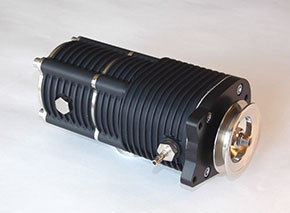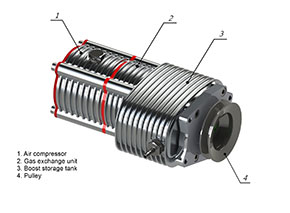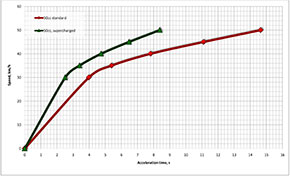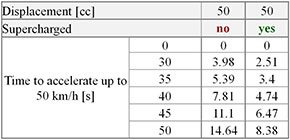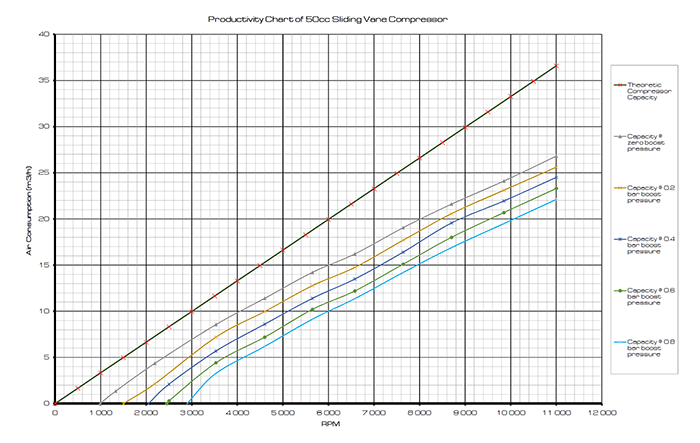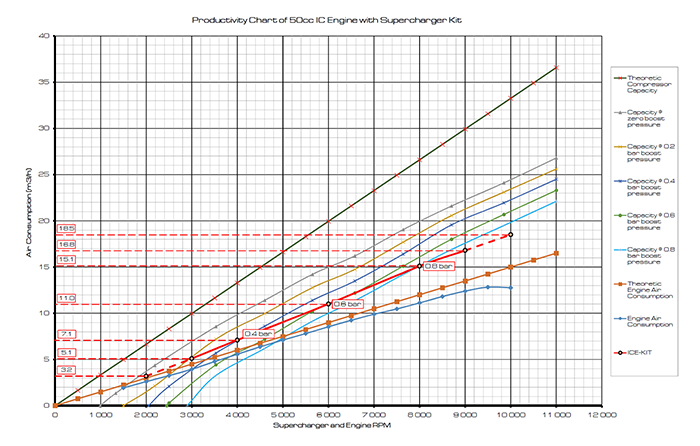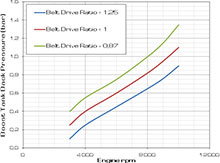Our supercharger can increase your motorcycle’s acceleration by 100%. The supercharger unit compresses and forces air into your engine. With the increased air supply more fuel can be used to improve the acceleration. Acceleration can be doubled. The perfected acceleration will provide you motorcycle with better maneuverability especially under extreme traffic situations.
General view of 50cc Supercharger
Compressor: Vane-type
Weight: 2.9kg,
Working rpm range: 500 … 10,000
Max rpm (cont): 10,000
Max rpm (inst): 12,500 rpm (within 60 seconds)
Max boost pressure: 1.2Bar (17.5 PSI)
- air compressor,
- boost storage tank
- gas exchange unit,
- drive pulley
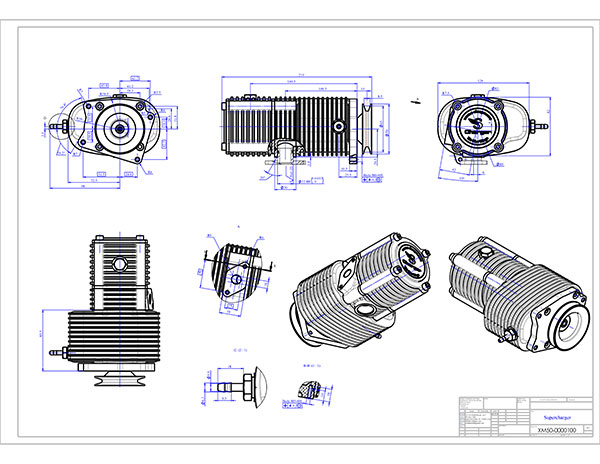 Dimensional Drawings — Download PDF
Dimensional Drawings — Download PDFOur innovations
- Our supercharger has been developed and optimized specifically for a 50cc 4-stroke engine.
- It’s quite safe for an engine to operate with our supercharger since air supply takes place in optimal mode.
- Our supercharger consists of an air compressor, a boost storage tank and a gas exchange unit providing steady performance of a small vehicle in different operation modes.
- The well known supercharger design has been adapted for small engines.
- We have developed a special unit that provides the adequate gas exchange at all allowed engine RPM.
- We have developed a mechanical control unit without any electronics and therefore its production cost is so low.
Acceleration test results and comparison diagram
Productivity Chart of 50cc Sliding Vane Compressor
Air productivity graphs of the supercharger are predicted and actually provided at different backpressure values from 0.0bar (with no backpressure) up to 0.8bar.
Supercharger air consumption values under backpressures are presented by almost straight lines. This feature was observed on all of our in-house-built Vane type compressors.
Productivity Chart of 50cc IC Engine with Supercharger
This diagram shows theoretical and actual capacity of the supercharger at different backpressures and also theoretical and actual curves of air consumption by the motorcycle engine.
Projection of intersection of backpressure value points in plenum at defined (chosen) rpm on Y axis shows actual engine air consumption at chosen rpm. As a result of conducting numerous tests we have determined optimal backpressure at the engine defined rpm, notably: 0.4bar @4,000rpm, 0.6bar@6,000rpm and 0.8bar@8,000rpm. Comparisons show the overall vehicle parameters, especially on its acceleration characteristics, reliability and other less important, the presented values of backup pressure on diagrams are optimal.
We have also tested other versions of backpressure, for example: 0.3bar @4,000rpm, 0.4bar@6,000rpm and 0.55bar@8,000rpm and even maximum possible from our point of view: 0.6bar @4,000rpm, 0.8bar@6,000rpm and 1.0bar@8,000rpm.
Boost pressure versus engine rpm at different pulleys’ ratio.
The diagram of the back pressure readings inside the boost storage tank characterizes “the quality” of the supercharger kit, e.g. its ability to supercharge the target motorbike engine in order to reach the set parameters. This diagram also presents the compliance of supercharger and engine capacities at different rpm.
Supercharger and manometer
Our video on the home page demonstrates readouts of back pressure in a plenum on air gauge. A very important thing is that readouts may be acquired by a fully opened throttle plate.
| Engine RPM | Boost Pressure | |
|---|---|---|
| Bar | PSI | |
| 3,000 | 0.3 | 4.4 |
| 4,000 | 0.4 | 5.8 |
| 6,000 | 0.6 | 8.7 |
| 8,000 | 0.8 | 11.6 |
| 9,000 | 0.9 | 13.1 |
| 10,000 | 1,0 | 14.5 |
There were many discussions whether to equip the kit with an air gauge. The practice along with numerous road tests showed that a manometer like a speedometer became an integral part of a motorcycle. The operator eventually binds speedometer readings with air gauge indications and intuitively defines the most appropriate driving mode under the given traffic conditions. Although air gauge is not one of the kit regular elements, we will strongly recommend its installation to supercharged motorcycle. The connector for pressure indicator is supplied with the purchase of every boost storage tank design. We also recommend the manometer with the scale of: -1Bar…+1.6Bar
Operation characteristics
Recommended pulley drive ratio
The recommended pulley drive ratio is 1:1.
The supercharger design assumes the required amount of air is supplied at the pulley drive ratio 1:1 and at 8,500rpm which is maximum allowed by the technical certificate.
The allowed pulley drive ratio up to 1:1.3
The supercharger design allows a small short-term rpm increase like up to 12,500 at its peak within 60 second range. It provides the short-term air supply increase. However, it also is dangerous because of the engine fast overheating. We recommend to use the engine thermometer under the ignition plug and control the temperature to make sure it is less than 180°. Otherwise the cylinder-piston couple can be destroyed.
Pulley rotation
Please note that the drive pulley rotates counterclockwise.
Supercharger drive belt
The adequate length belt of standard Z profile with the top width (10mm) and height (6mm) is used.
See the link below for more details: V-Belt
Recommended temperature
Operation temperature for the modified motorcycle is 10°C to 40°C.
Fuel
Fuel recommended for the modified motorcycle has 95 octane number as the high octane number prevents the possible detonation.
Carburetor and main jet diameter
To get the right stoichiometric ratio for the fuel/air mixture we need to replace the stock jet by the one of bigger diameter in order to match the higher air supply to greater fuel supply.
The original engine Z50/AB27 jet diameter is 0.58mm to 0.62mm (depending on the design version). During the supercharger installation we recommend (1) leave the original carburetor and(2) replace the main jet with the one of greater diameter. The optimal diameter of the main jet for the supercharged motorcycle is 0.76mm. In this case the delay and failure are eliminated when the operator suddenly changes the gas lever position. You can also conduct a very simple experiment to find out the appropriate jet diameter within 0.72mm to 0.80mm.
Usually jet sets come with 0.02mm increment of their inner diameter.
The serious post installation tuning could be needed at the jet replacement to determine the optimal jet diameter. We are thinking about the simple method of jet selection. The fully detailed method will be shared with the supercharged motorcycle operators on our website.

